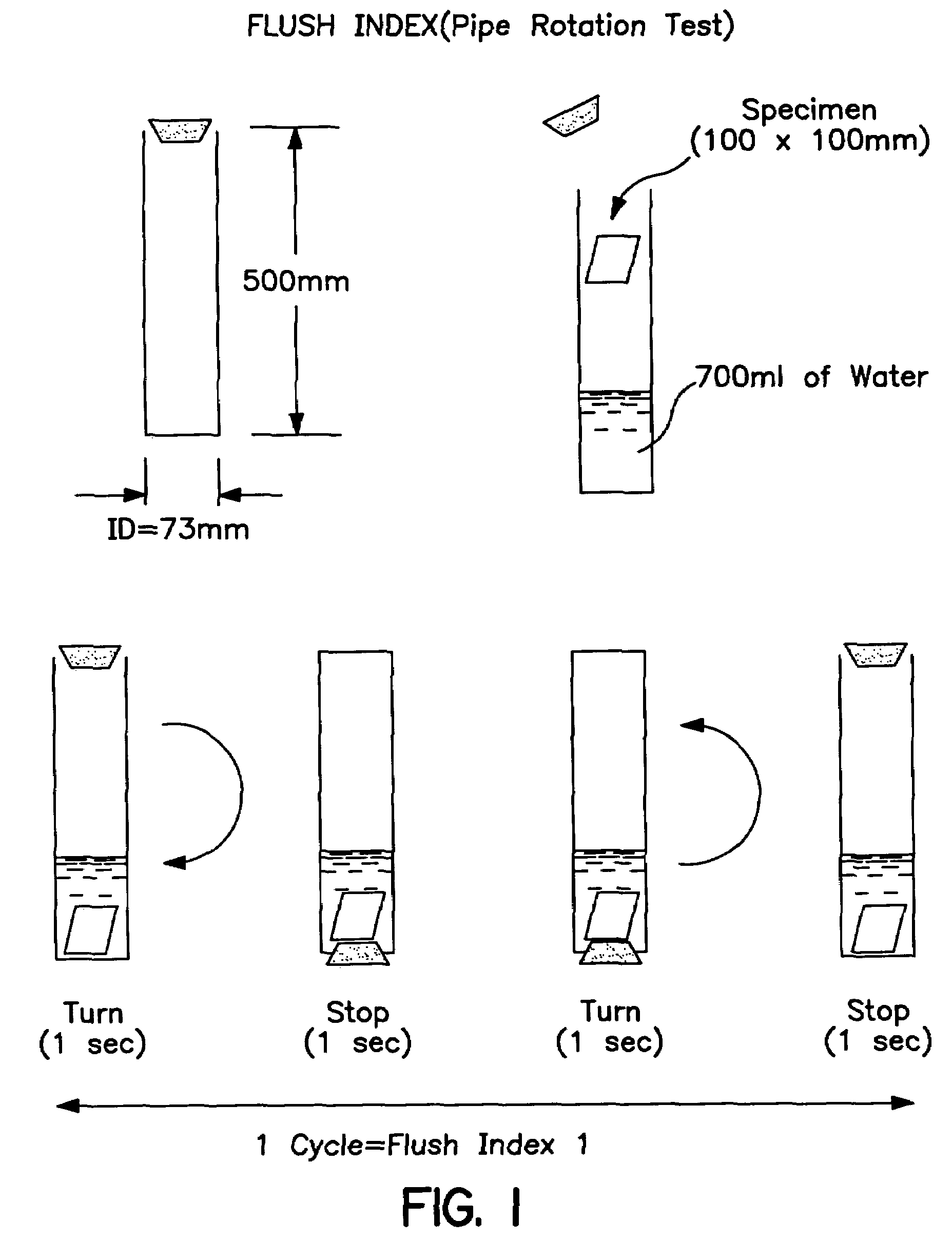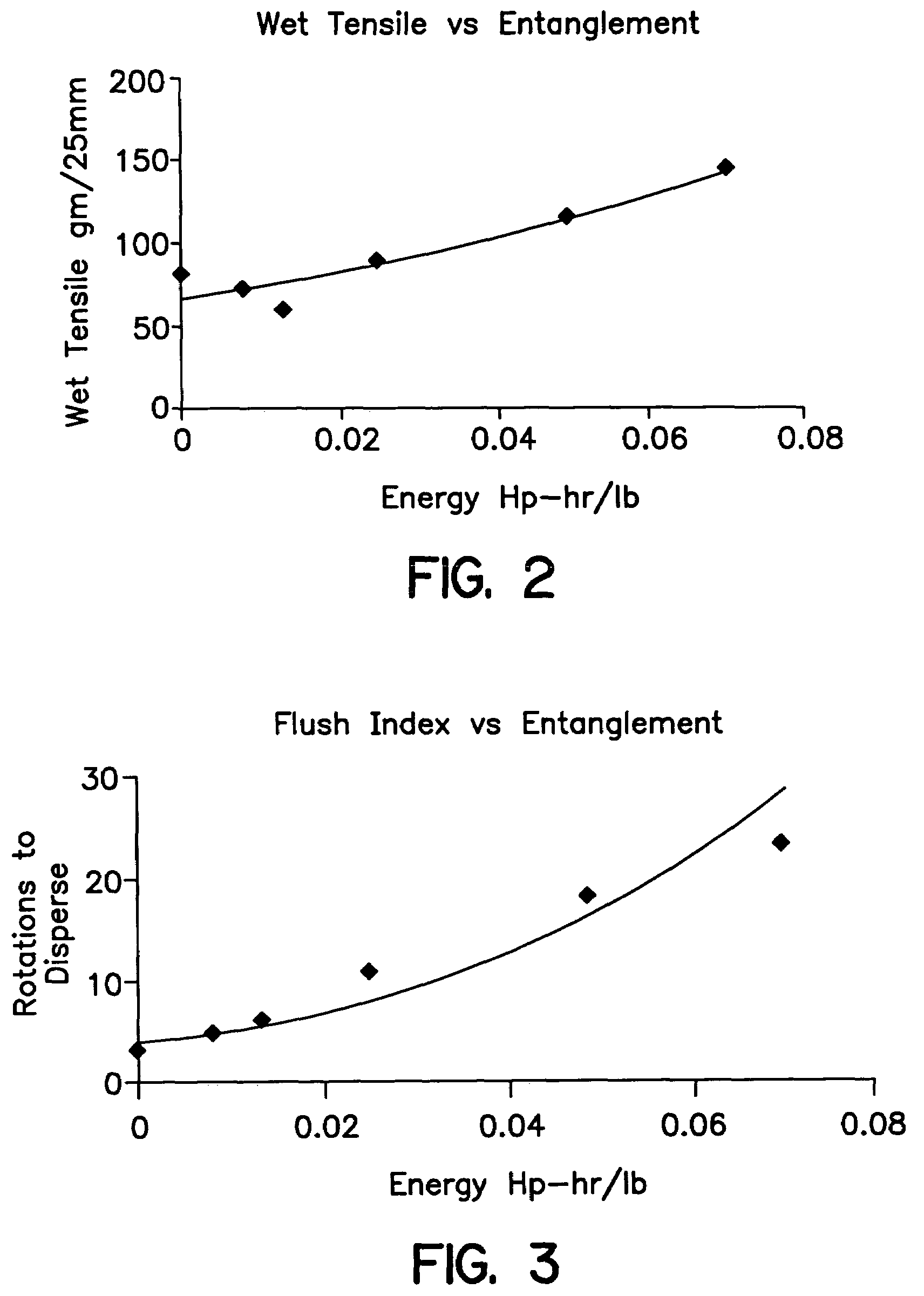Disposable nonwoven wiping fabric and method of production
a non-woven cloth and fabric technology, applied in the field of new and improved fibrous non-woven sheet materials, can solve the problems of difficult breakage, poor wet strength of such materials, especially at low basis weights, and achieve excellent hand and aesthetics, good wet strength, and high bulk or thickness.
- Summary
- Abstract
- Description
- Claims
- Application Information
AI Technical Summary
Benefits of technology
Problems solved by technology
Method used
Image
Examples
example 1
[0058]A series of nonwoven sheet samples were produced. The samples were formed on an inclined wire papermaking machine set at 75 feet per minute and a basis weight of 55 gsm. The wet web materials were passed under two water jet entanglement nozzles, each nozzle fitted with a strip having 51 holes per inch, each hole having an orifice diameter of 92 microns. The nozzle pressures were set at 400 and 450 psi, yielding entanglement energy of 0.028 Hp-hr / lb. The web materials were supported on a forming fabric during the entanglement phase of production. The web materials were then dried on steam heated rotary drying cans having a temperature of about 300 degrees Fahrenheit. Synthetic binder fibers were activated during drying.
[0059]Each of the samples comprised the same type and percentage of wood pulp fibers and bicomponent binder fibers. Additionally, sample 1a comprised 20 percent, 8 mm by 1.5 denier viscose rayon fiber. Sample 1b replaced the viscose rayon fiber with 20 percent, 8...
example 2
[0062]Samples of a disintegratable nonwoven sheet were produced on an inclined wire paper making machine set at a speed of 130 meters per minute and a basis weight of 55 gsm. Sample 2a was comprised of wood pulp fibers, bicomponent binder fibers and 8 mm by 1.5 denier viscose rayon fibers. Sample 2b was comprised of wood pulp fibers, bicomponent binder fibers and 10 mm by 1.25 denier lyocell fibers. Each web material was passed under three water jet entanglement nozzles, each nozzle fitted with a strip having 51 holes per inch, each hole having an orifice diameter of 92 microns. The pressure on the three rows of nozzles was set at 440 psi each, yielding a total entanglement energy of 0.007 Hp-hr / lb. The web materials were supported on a fabric during the entanglement phase of production. The fabrics were then dried on rotary drying cans heated to about 300 degrees Fahrenheit and through air dryers set at a temperature of about 390 degrees Fahrenheit. Synthetic binder fibers were act...
example 3
[0065]A series of nonwoven sheets were produced on an inclined wire papermaking machine set at 75 feet per minute and a basis weight of 55 gsm. The wet web materials were passed under two water jet entanglement nozzles; each nozzle fitted with a strip having 51 holes per inch, each hole having an orifice diameter of 92 microns. The nozzle pressures were set at 365 and 445 psi yielding 0.026 Hp-hr / lb entanglement energy. The substrates were supported on a forming fabric during the entanglement phase of production. The fabrics were then dried on steam heated rotary drying cans having a temperature of about 300 degrees Fahrenheit. Synthetic binder fibers, if present, were activated during the drying step.
[0066]
TABLE 3Sample3a3b3c3d% Wood Pulp808078.578.5% Bicomponent001.51.5% Viscose Rayon20—20—(8 mm × 1.5 dpf)% Lyocell (8 mm × 1.5 dpf)—20—20Entanglement energy (Hp-hr / lb)0.0260.0260.0260.026Basis Weight (gsm)53.052.05555.6Thickness (microns)469435445430Wet Tensile (gm / 25 mm)MD113150190...
PUM
| Property | Measurement | Unit |
|---|---|---|
| Fraction | aaaaa | aaaaa |
| Fraction | aaaaa | aaaaa |
| Fraction | aaaaa | aaaaa |
Abstract
Description
Claims
Application Information
 Login to View More
Login to View More - R&D
- Intellectual Property
- Life Sciences
- Materials
- Tech Scout
- Unparalleled Data Quality
- Higher Quality Content
- 60% Fewer Hallucinations
Browse by: Latest US Patents, China's latest patents, Technical Efficacy Thesaurus, Application Domain, Technology Topic, Popular Technical Reports.
© 2025 PatSnap. All rights reserved.Legal|Privacy policy|Modern Slavery Act Transparency Statement|Sitemap|About US| Contact US: help@patsnap.com



